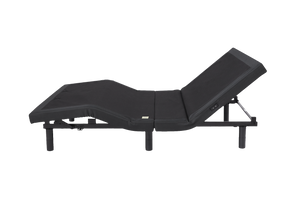Almost overnight, remote work has become a norm for many of us. Yet, the health implications of teleworking are considerable. In fact, as an osteopath, I can see the effects of it on a daily basis.
In osteopathy, home office ergonomics can be a determining factor in the understanding of ailments of those who consult.
Bad sleep, backache, or headaches are often the consequences of a poor posture. The disadvantages of remote work in terms of ergonomics are the same as those previously encountered in the office.
But this situation has the advantage of offering us the opportunity to modulate our workspace as we wish. From now on, it is our office, our rules!
And to make your office a place where you'll feel really comfortable, I offer you this little guide to find the ideal posture when you work remotely!
1. Balance your spine

Finding the ideal remote work posture starts with balancing your spine. While sitting or standing for an extended period of time, the head, shoulders, and pelvis should remain as aligned as possible:
Imagine an axis between the center of your perineum and the top of your skull:
- Stretch these two points to the maximum,
- Relax the shoulders,
- And keep this axis vertical.
To respect the natural curves of your spine:
- Tilt the top of the pelvis forward, and move the shoulders back slightly to keep the axis between the skull and the perineum vertical,
- Look straight ahead, a fixed point at eye level, without rotating your trunk or head,
- Finally, adjust the position of your head by placing your chin in line with your sternum (the bone in front of your heart). Generally, this last adjustment consists of moving your head back a little from your trunk to align your ears with your shoulder line.
Good home office ergonomics consist above all in organizing it in such a way as not to disturb the postural balance of the spine. This way, back pain due to remote work will be a bad memory!
The next step to improve your home office ergonomics consists of adjusting your tools, starting with the chair.
2. Adjust your chair’s height

The right height for the chair depends mainly on the height of your desk. Ideally, both legs should lie flat on the floor, with the knees at a right angle.
But the key is to sit high enough to keep your shoulders relaxed when your hands are on the keyboard.
A hint: your elbows will be about the same height as your wrists, with your forearms flat on the desk.
3. Adjust the screen position

Finally, your screen position is crucial for good home office ergonomics.
Do you remember the point at eye level that you were staring at earlier? Now, place the center of your screen at that exact spot. Yes, it's a lot higher than usual, and you'll probably have to use more books than expected to adjust the position of your screen!
The good news is that the books will now do this compensatory work instead of your back muscles. Your muscles will thank you, and your sleep hygiene will improve.
In summary, to avoid fatigue and back pain after a day of teleworking, it is important to place the screen in front of you and at eye level when standing upright.
Considering the previous 3 points, your posture should look like this :

4. Taking Breaks

Ergonomics isn't everything, and the link between telecommuting and muscle fatigue also comes from the fact that we stay in the same position for too long.
It is therefore a matter of getting up from your chair as regularly as possible: at least 1 minute every 45 minutes, to move and let off steam. The advantage of telecommuting in this respect is that no one is watching you.
So don't deprive yourself: jump on the spot, stretch out in all directions, go jogging in your living room, scream into a pillow... All means are good for releasing accumulated tensions.
In fact, take the opportunity to close your eyes. Eye fatigue is also a major contributor to headaches and difficulty falling asleep at bedtime.
Outside of work, take part in regular physical activity. This will help your body to tolerate these prolonged static positions.
5. Separate the teleworking zone from rest areas
Adjusting posture and organizing home office ergonomics are the cornerstones of our remote work guide. However, we must not forget the psychological aspect, as this is often the main drawback of teleworking.
Indeed, telework introduces our work spatially and mentally into the kitchen, dining room, living room, or worse, the bedroom. All these spaces were previously dedicated to relaxation, comfort, and rest. As we know, stress has an effect on sleep, and telework can sometimes bring its share of anxiety to the bedroom (and/or other rooms).
Therefore, be careful to separate the spaces and moments dedicated to work from those intended for these elements essential to our psychological balance.
In other words, not working in your bedroom and eating meals outside of your workspace is a good start to avoid insomnia, indigestion, and depression.
So are you ready to make the home the office space you've always dreamed of?





























